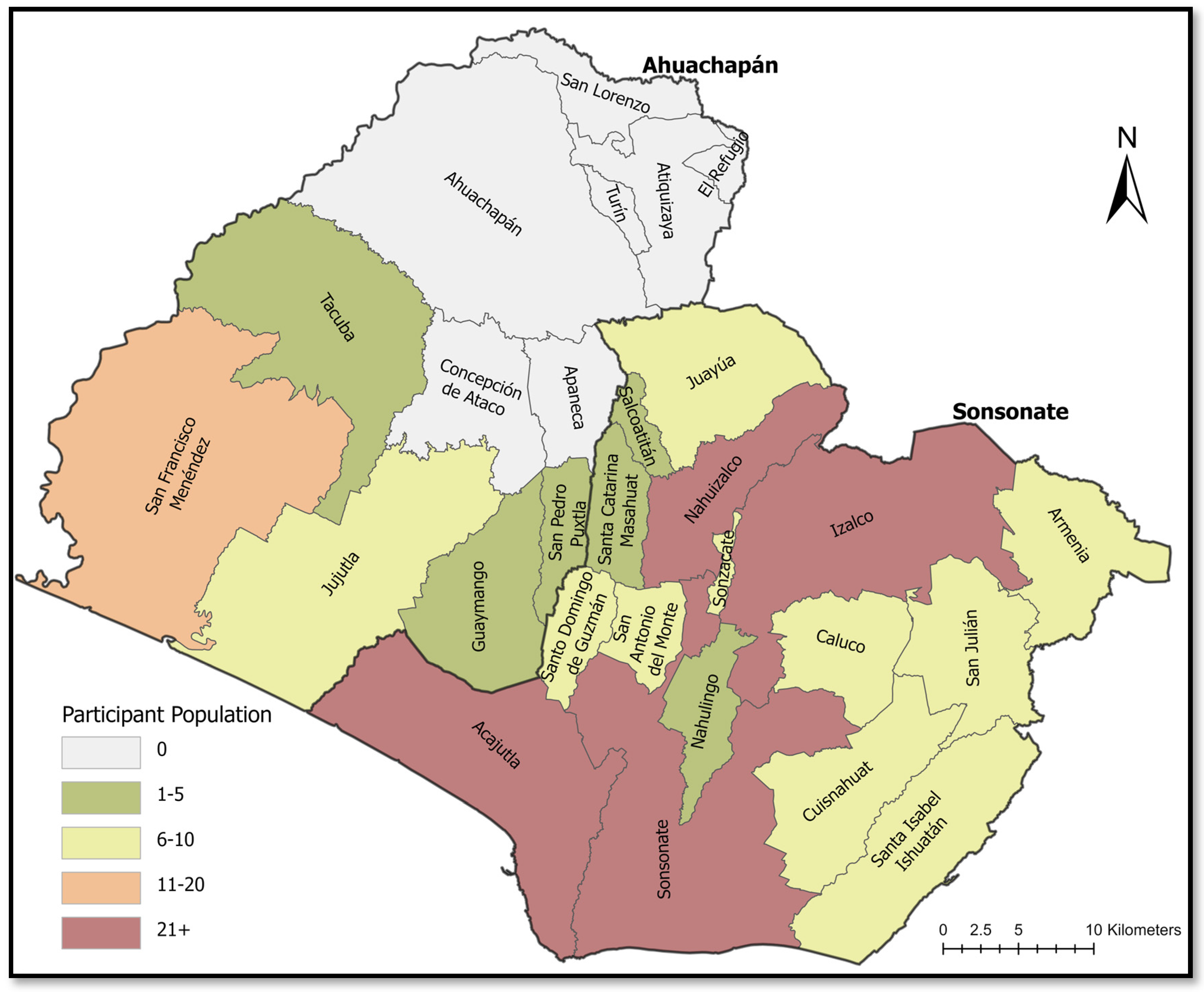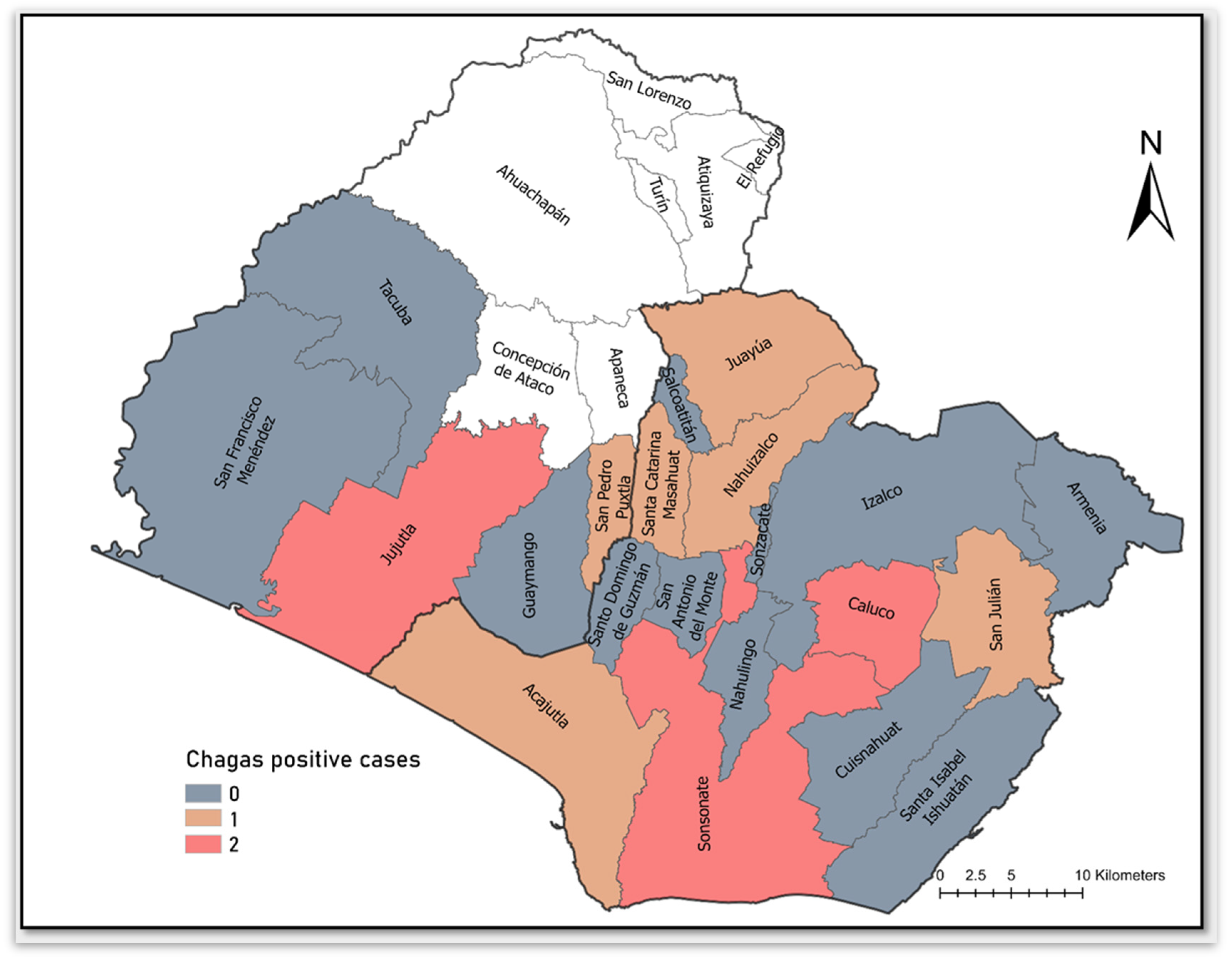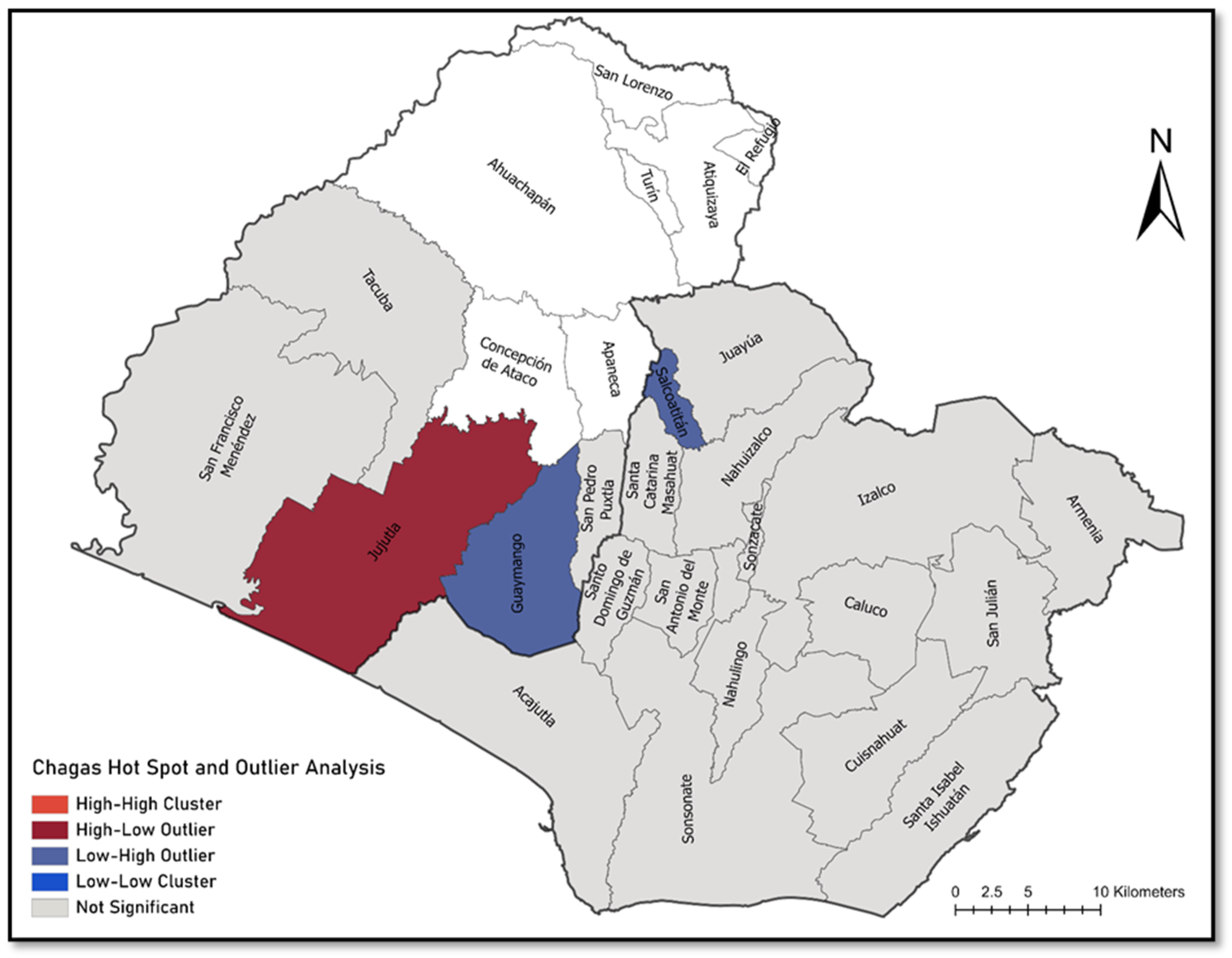Chagas Disease Maternal Seroprevalence and Maternal–Fetal Health Outcomes in a Parturition Cohort in Western El Salvador
Abstract
1. Introduction
2. Materials and Methods
3. Results
4. Discussion
5. Conclusions
Supplementary Materials
Author Contributions
Funding
Institutional Review Board Statement
Informed Consent Statement
Data Availability Statement
Acknowledgments
Conflicts of Interest
References
- Dye-Braumuller, K.C.; Lynn, M.K.; Nolan, M.S. History of indigenous Trypanosoma cruzi infection in humans, animals and triatomines in California, USA. Zoonoses Public Health 2020, 68, 299–308. [Google Scholar] [CrossRef]
- Sasagawa, E.; Aiga, H.; Soriano, E.Y.C.; Marroquín, B.L.C.; Ramírez, M.A.H.; de Aguilar, A.V.G.; Chévez, J.E.R.; Hernández, H.M.R.; Cedillos, R.A.; Misago, C. Mother-to-child transmission of chagas disease in El Salvador. Am. J. Trop. Med. Hyg. 2015, 93, 326–333. [Google Scholar] [CrossRef]
- Bern, C.; Messenger, L.A.; Whitman, J.D.; Maguire, J.H. Chagas disease in the United States: A public health approach. Clin. Microbiol. Rev. 2019, 33, e00023-19. [Google Scholar] [CrossRef]
- Matthews, S.; Tannis, A.; Puchner, K.P.; Bottazzi, M.E.; Cafferata, M.L.; Comandé, D.; Buekens, P. Estimation of the morbidity and mortality of congenital Chagas disease: A systematic review and meta-analysis. PLoS Negl. Trop. Dis. 2022, 16, e0010376. [Google Scholar] [CrossRef]
- Edwards, M.S.; Abanyie, F.A.; Montgomery, S.P. Survey of Pediatric Infectious Diseases Society Members about Congenital Chagas Disease. Pediatr. Infect. Dis. J. 2018, 37, e24–e27. [Google Scholar] [CrossRef]
- Buekens, P.; Cafferata, M.L.; Alger, J.; Althabe, F.; Belizán, J.M.; Bustamante, N.; Carlier, Y.; Ciganda, A.; Del Cid, J.H.; Dumonteil, E. Congenital transmission of Trypanosoma cruzi in Argentina, Honduras, and Mexico: An observational prospective study. Am. J. Trop. Med. Hyg. 2018, 98, 478–485. [Google Scholar] [CrossRef]
- Carlier, Y.; Sosa-Estani, S.; Luquetti, A.O.; Buekens, P. Congenital Chagas disease: An update. Mem. Do Inst. Oswaldo Cruz 2015, 110, 363–368. [Google Scholar] [CrossRef]
- Santana, K.H.; Oliveira, L.G.R.; Barros de Castro, D.; Pereira, M. Epidemiology of Chagas disease in pregnant women and congenital transmission of Trypanosoma cruzi in the Americas: Systematic review and meta-analysis. Trop. Med. Int. Health 2020, 25, 752–763. [Google Scholar] [CrossRef]
- Pinesi, H.T.; Strabelli, T.M.V.; Aiello, V.D. Case 4/2019-26-Year-Old Man with Congenital Chagas Disease and Heart Transplantation. Arq. Bras. Cardiol. 2019, 113, 286–293. [Google Scholar] [CrossRef]
- Salazar-Schettino, P.M.; Cabrera-Bravo, M.; Vazquez-Antona, C.; Zenteno, E.; Alba-Alvarado, M.; Gutierrez, E.T.; Gomez, Y.G.; Perera-Salazar, M.G.; Torre, G.G.; Bucio-Torres, M.I. Chagas Disease in Mexico: Report of 14 Cases of Chagasic Cardiomyopathy in Children. Tohoku J. Exp. Med. 2016, 240, 243–249. [Google Scholar] [CrossRef]
- Sasagawa, E.; Aguilar, A.V.G.d.; Ramírez, M.A.H.d.; Chévez, J.E.R.; Nakagawa, J.; Cedillos, R.A.; Kita, K. Acute Chagas disease in El Salvador 2000-2012-Need for surveillance and control. Memórias Do Inst. Oswaldo Cruz 2014, 109, 256–258. [Google Scholar] [CrossRef]
- Traina, M.I.; Sanchez, D.R.; Hernandez, S.; Bradfield, J.S.; Labedi, M.R.; Ngab, T.A.; Steurer, F.; Montgomery, S.P.; Meymandi, S.K. Prevalence and impact of Chagas disease among Latin American immigrants with nonischemic cardiomyopathy in Los Angeles, California. Circ. Heart Fail. 2015, 8, 938–943. [Google Scholar] [CrossRef]
- Bern, C.; Montgomery, S.P. An estimate of the burden of Chagas disease in the United States. Clin. Infect. Dis. 2009, 49, e52–e54. [Google Scholar] [CrossRef]
- Carlier, Y.; Truyens, C. Congenital Chagas disease as an ecological model of interactions between Trypanosoma cruzi parasites, pregnant women, placenta and fetuses. Acta Trop. 2015, 151, 103–115. [Google Scholar] [CrossRef]
- Dorn, P.L.; McClure, A.G.; Gallaspy, M.D.; Waleckx, E.; Woods, A.S.; Monroy, M.C.; Stevens, L. The diversity of the Chagas parasite, Trypanosoma cruzi, infecting the main Central American vector, Triatoma dimidiata, from Mexico to Colombia. PLoS Negl. Trop. Dis. 2017, 11, e0005878. [Google Scholar] [CrossRef]
- PAHO. Central America Conquers an Exotic Vector; Pan American Health Organization: Washington, DC, USA, 2016. [Google Scholar]
- Peterson, J.K.; Yoshioka, K.; Hashimoto, K.; Caranci, A.; Gottdenker, N.; Monroy, C.; Saldaña, A.; Rodriguez, S.; Dorn, P.; Zúniga, C. Chagas Disease Epidemiology in Central America: An Update. Curr. Trop. Med. Rep. 2019, 6, 92–105. [Google Scholar] [CrossRef]
- Murcia Contreras DERA, S. Ministerio de salud de El Salvador: Situacion Actual de Chagas en la Region Occidental de El Salvador. In Proceedings of the Congreso Internacional de Vectores y del Trypanosoma Cruzi: Simposio Internacional Sobre la Enfermedad de Chagas, Cuernavaca, Mexico, 8 December 2016. [Google Scholar]
- Nolan, M.S.; Murray, K.O.; Mejia, R.; Hotez, P.J.; Villar Mondragon, M.J.; Rodriguez, S.; Palacios, J.R.; Murcia Contreras, W.E.; Lynn, M.K.; Torres, M.E. Elevated Pediatric Chagas Disease Burden Complicated by Concomitant Intestinal Parasites and Malnutrition in El Salvador. Trop. Med. Infect. Dis. 2021, 6, 72. [Google Scholar] [CrossRef]
- Sasagawa, E.; Aiga, H.; Corado, E.Y.; Cuyuch, B.L.; Hernández, M.A.; Guevara, A.V.; Romero, J.E.; Ramos, H.M.; Cedillos, R.A.; Misago, C. Risk factors for Chagas disease among pregnant women in El Salvador. Trop. Med. Int. Health 2015, 20, 268–276. [Google Scholar] [CrossRef]
- Pérez Mata, B.; Franco Márquez, V.; Flores Moreno, I. Incidencia de la Enfermedad de Chagas en mujeres Embarazadas de 10 a 49 años de las Unidades Comunitarias de Salud Familiar: Ciudad Barrios (San Miguel), Chilanga (Morazán) y Cantón el Piche (La Unión) en el Periodo de Septiembre a Noviembre de 2012. Ph.D. Thesis, Universidad de El Salvador, San Salvador, El Salvador, 2013. [Google Scholar]
- Ventura Urbino, F.; Caledonio Blanco, E.; Arya Bonilla, D. Enfermedad de Chagas en Mujeres en el Tercer Trimestre de Gestacion y su Transmision Transplacentaria, que Asisten al Control Prenatal de la Unidad Comunitaria de Salud Familiar de Conchagua del Departamento de La Union Periodo de Julio-Agosto 2012. Bachelor’s Thesis, Universidad de El Salvador, San Salvador, El Salvador, 2012. [Google Scholar]
- Carlier, Y.; Altcheh, J.; Angheben, A.; Freilij, H.; Luquetti, A.O.; Schijman, A.G.; Segovia, M.; Wagner, N.; Albajar Vinas, P. Congenital Chagas disease: Updated recommendations for prevention, diagnosis, treatment, and follow-up of newborns and siblings, girls, women of childbearing age, and pregnant women. PLoS Negl. Trop. Dis. 2019, 13, e0007694. [Google Scholar] [CrossRef]
- Ramírez, J.D.; Herrera, G.; Hernández, C.; Cruz-Saavedra, L.; Muñoz, M.; Flórez, C.; Butcher, R. Evaluation of the analytical and diagnostic performance of a digital droplet polymerase chain reaction (ddPCR) assay to detect Trypanosoma cruzi DNA in blood samples. PLoS Negl. Trop. Dis. 2018, 12, e0007063. [Google Scholar] [CrossRef]
- Duffy, T.; Cura, C.I.; Ramirez, J.C.; Abate, T.; Cayo, N.M.; Parrado, R.; Bello, Z.D.; Velazquez, E.; Muñoz-Calderon, A.; Juiz, N.A. Analytical performance of a multiplex Real-Time PCR assay using TaqMan probes for quantification of Trypanosoma cruzi satellite DNA in blood samples. PLoS Negl. Trop. Dis. 2013, 7, e2000. [Google Scholar] [CrossRef]
- Ramírez, J.C.; Cura, C.I.; da Cruz Moreira, O.; Lages-Silva, E.; Juiz, N.; Velázquez, E.; Ramírez, J.D.; Alberti, A.; Pavia, P.; Flores-Chávez, M.D. Analytical validation of quantitative real-time PCR methods for quantification of Trypanosoma cruzi DNA in blood samples from Chagas disease patients. J. Mol. Diagn. 2015, 17, 605–615. [Google Scholar] [CrossRef]
- Meymandi, S.K.; Forsyth, C.J.; Soverow, J.; Hernandez, S.; Sanchez, D.; Montgomery, S.P.; Traina, M. Prevalence of Chagas disease in the Latin American–born population of Los Angeles. Clin. Infect. Dis. 2017, 64, 1182–1188. [Google Scholar] [CrossRef]
- Espinoza, B.; Martínez, I.; Schabib-Hany, M. First report of family clusters of Chagas disease seropositive blood donors in Mexico City and their epidemiological relevance. Acta Trop. 2019, 193, 23–30. [Google Scholar] [CrossRef]
- Messenger, L.A.; Gilman, R.H.; Verastegui, M.; Galdos-Cardenas, G.; Sanchez, G.; Valencia, E.; Sanchez, L.; Malaga, E.; Rendell, V.R.; Jois, M. Toward improving early diagnosis of congenital Chagas disease in an endemic setting. Clin. Infect. Dis. 2017, 65, 268–275. [Google Scholar] [CrossRef]
- Kemmerling, U.; Osuna, A.; Schijman, A.G.; Truyens, C. Congenital Transmission of Trypanosoma cruzi: A review about the interactions between the parasite, the placenta, the maternal and the fetal/neonatal immune responses. Front. Microbiol. 2019, 10, 1854. [Google Scholar] [CrossRef]
- Rios, L.; Campos, E.E.; Menon, R.; Zago, M.P.; Garg, N.J. Epidemiology and pathogenesis of maternal-fetal transmission of Trypanosoma cruzi and a case for vaccine development against congenital Chagas disease. Biochim. Biophys. Acta (BBA)-Mol. Basis Dis. 2020, 1866, 165591. [Google Scholar] [CrossRef]
- Cevallos, A.M.; Hernández, R. Chagas’ disease: Pregnancy and congenital transmission. BioMed Res. Int. 2014, 2014, 401864. [Google Scholar] [CrossRef]
- Salvador, G.d.E. Medición Multidimensional de la Pobreza; Ministerio de Economía, Secretaría Técnica y de Planificación: San Salvador, El Salvador, 2017; Volume 45. [Google Scholar]
- Kelly, E.A.; Bulman, C.A.; Gunderson, E.L.; Irish, A.M.; Townsend, R.L.; Sakanari, J.A.; Stramer, S.L.; Bern, C.; Whitman, J.D. Comparative performance of latest-generation and FDA-cleared serology tests for the diagnosis of Chagas disease. J. Clin. Microbiol. 2021, 59, e00158-21. [Google Scholar] [CrossRef]
- Pomari, E.; Piubelli, C.; Perandin, F.; Bisoffi, Z. Digital PCR: A new technology for diagnosis of parasitic infections. Clin. Microbiol. Infect. 2019, 25, 1510–1516. [Google Scholar] [CrossRef]
- Rodríguez, M.S.; Nitahara, Y.; Cornejo, M.; Siliezar, K.; Grande, R.; González, A.; Tasaki, K.; Nakagama, Y.; Michimuko, Y.; Onizuka, Y. Re-emerging threat of Trypanosoma cruzi vector transmission in El Salvador, update from 2018 to 2020. Infect. Dis. Poverty 2022, 11, 89. [Google Scholar] [CrossRef]
- Aiga, H.; Sasagawa, E.; Hashimoto, K.; Nakamura, J.; Zúniga, C.; Chevez, J.E.; Hernandez, H.M.; Nakagawa, J.; Tabaru, Y. Chagas disease: Assessing the existence of a threshold for bug infestation rate. Am. J. Trop. Med. Hyg. 2012, 86, 972–979. [Google Scholar] [CrossRef]
- MINSAL. Informe Nacional Situación del VIH en El Salvador Año 2020; Ministerio de Salud: San Salvador, El Salvador, 2021; Volume 61. [Google Scholar]
- Sasagawa, E.; Guevara de Aguilar, A.V.; Hernández de Ramírez, M.A.; Romero Chévez, J.E.; Nakagawa, J.; Cedillos, R.A.; Misago, C.; Kita, K. Prevalence of Trypanosoma cruzi infection in blood donors in El Salvador between 2001 and 2011. J. Infect. Dev. Ctries. 2014, 8, 1029–1036. [Google Scholar] [CrossRef]
- MINSAL. Lineamientos Técnicos Para la Atención de la Mujer en el Período Preconcepcional, Prenatal, Parto, Puerperio y al Recién Nacido. Servicios en SSR Para Atención de Emergencias o Desastres; Ministerio de Salud: San Salvador, El Salvador, 2021. [Google Scholar]
- Amaya Mancía, C.; Ling Romero, N.; Elizabeth Sanchez, T. Evaluacion de la Calidad de la Atencion de Los Controles Prenatales Basicos Brindados a Las Mujeres Embarazadas, Por el Equipo Comunitario de Salud Familiar Urbano de el Municipio de Chalchuapa Departamento de Santa Ana, en el Periodo de Enero a Diciembre de 2012. Ph.D. Thesis, Universidad de El Salvador, San Salvador, El Salvador, 2013. [Google Scholar]
- Hotez, P.J. Neglected Infections of Poverty in the United States of America. PLoS Negl. Trop. Dis. 2008, 2, e256. [Google Scholar] [CrossRef]
- Mahoney West, H.; Milliren, C.E.; Manne-Goehler, J.; Davis, J.; Gallegos, J.; Perez, J.H.; Köhler, J.R. Effect of clinician information sessions on diagnostic testing for Chagas disease. PLoS Negl. Trop. Dis. 2022, 16, e0010524. [Google Scholar] [CrossRef]
- Andrade, D.V.; Gollob, K.J.; Dutra, W.O. Acute Chagas disease: New global challenges for an old neglected disease. PLoS Negl. Trop. Dis. 2014, 8, e3010. [Google Scholar] [CrossRef]



| % (N) Total Study Population (n = 198) | % (N) Chagas (+) Mothers (n = 12) | % (N) Chagas (−) Mothers (n = 186) | * p-Value, Fisher’s Exact Statistic | |
|---|---|---|---|---|
| Department | 0.415 | |||
| Ahuachapan | 16.2% (32) | 25.0% (3) | 15.6% (29) | |
| Sonsonate | 83.8% (166) | 75.0% (9) | 84.4% (157) | |
| Age Group | 0.002 | |||
| <18 years | 7.1% (14) | 8.3% (1) | 7.0% (13) | |
| 18–25 years | 43.9% (87) | 8.3% (1) | 46.2% (86) | |
| 26–30 years | 21.7% (43) | 8.3% (1) | 22.6% (42) | |
| 31–45 years | 27.3% (54) | 75.0% (9) | 24.2% (45) | |
| History of Miscarriage | 0.370 | |||
| No | 89.4% (177) | 83.3% (10) | 89.8% (167) | |
| Yes | 10.6% (21) | 16.7% (2) | 10.2% (19) | |
| High Risk Pregnancy (current) | 0.119 | |||
| No | 83.3% (165) | 66.7% (8) | 84.4% (157) | |
| Yes | 16.7% (33) | 33.3% (4) | 15.6% (29) | |
| Prior pregnancy complications (any) | 0.051 | |||
| No | 92.4% (183) | 75.0% (9) | 92.5% (172) | |
| Yes | 7.6% (15) | 25.0% (3) | 6.5% (12) | |
| Mother’s education level | 0.022 | |||
| ≤6th grade | 43.4% (86) | 58.3% (7) | 42.5% (79) | |
| 7th grade–11th grade | 25.8% (51) | 16.7% (2) | 26.3% (49) | |
| High school | 28.3% (56) | 8.3% (1) | 29.6% (55) | |
| University or Graduate | 2.5% (5) | 16.7% (2) | 1.6% (3) | |
| Number of prior children * | 0.096 | |||
| none | 36.9% (73) | 33.3% (4) | 37.3% (69) | |
| 1–3 | 59.1% (117) | 50.0% (6) | 60.0% (111) | |
| 4+ | 3.5% (7) | 16.7% (2) | 2.7% (5) | |
| Knowledge of Chagas Disease | 1.0 | |||
| No | 82.3% (163) | 83.3% (10) | 82.3% (153) | |
| Yes | 17.7% (35) | 16.7% (2) | 17.7% (33) | |
| Knowledge of triatomines * | 0.349 | |||
| No | 39.4% (78) | 50.0% (6) | 38.9% (72) | |
| Yes | 60.1% (119) | 41.6% (5) | 61.6% (114) | |
| Knowing someone with Chagas disease | 0.021 | |||
| No | 94.4% (187) | 75.0% (9) | 95.7% (178) | |
| Yes | 5.6% (11) | 25.0% (3) | 4.3% (8) | |
| Have electricity in the home * | 1.0 | |||
| No | 7.6% (15) | 0% (0) | 8.1% (15) | |
| Yes | 91.9% (182) | 91.7% (11) | 91.9% (171) | |
| Significant substandard housing level * | 0.089 | |||
| No | 69.7% (138) | 41.6% (5) | 71.5% (133) | |
| Yes | 29.8% (59) | 50.0% (6) | 28.5% (53) | |
| Total number in household * | 1.0 | |||
| <3 | 19.7% (39) | 16.7% (2) | 20.0% (37) | |
| 4–6 | 67.7% (134) | 75.0% (9) | 67.6% (125) | |
| 7+ | 12.1% (24) | 8.3% (1) | 12.4% (23) | |
| % (N) Total Study Population (n = 198) | % (N) Chagas (+) Mothers (n = 12) | % (N) Chagas (−) Mothers (n = 186) | p-Value, Fisher’s Exact Statistic | |
|---|---|---|---|---|
| Pregnancy Complications | ||||
| Any complications | 22.2% (44) | 58.3% (7) | 19.9% (37) | 0.006 |
| Gestational diabetes | 2.0% (4) | 16.7% (2) | 1.1% (2) | 0.019 |
| Threat of miscarriage | 9.6% (19) | 8.3% (1) | 9.7% (18) | 1.0 |
| Placenta previa or acreta | 2.0% (4) | 0% (0) | 2.2% (4) | 1.0 |
| Cesarean section (c-section) | 55.1% (109) | 100.0% (12) | 52.2% (97) | 0.001 |
| Breech birth | 4.0% (8) | 0% (0) | 4.3% (8) | 1.0 |
| Urinary tract infection (UTI) during pregnancy | 2.5% (5) | 0% (0) | 2.7% (5) | 1.0 |
| Labor and Delivery Complications | ||||
| Any | 11.6% (23) | 25.0% (3) | 10.7% (20) | 0.159 |
| Premature rupture of membranes (PROM) | 5.6% (11) | 8.3% (1) | 5.4% (10) | 0.514 |
| Neonatal symptoms at birth | ||||
| Any symptom | 10.1% (20) | 33.3% (4) | 8.6% (16) | 0.024 |
| Low birthweight | 7.6% (15) | 16.7% (2) | 7.0% (13) | 0.234 |
| Apgar 1 min < 9 | 7.1% (14) | 33.3% (4) | 5.4% (10) | 0.006 |
| Apgar 5 min < 9 | 1.5% (3) | 16.7% (2) | 0.5% (1) | 0.010 |
| Admitted to neonatal intensive care (NICU) | 20.2% (40) | 50.0% (6) | 18.3% (34) | 0.020 |
| Premature birth | 5.6% (11) | 8.3% (1) | 5.4% (10) | 0.514 |
| Meconium aspiration syndrome (MAS) | 2.5% (5) | 16.7% (2) | 1.6% (3) | 0.032 |
| Acute respiratory distress syndrome (ARDS) | 5.6% (11) | 16.7% (2) | 4.8% (9) | 0.141 |
| Respiratory assistance (hood) | 5.6% (11) | 16.7% (2) | 4.8% (9) | 0.141 |
Disclaimer/Publisher’s Note: The statements, opinions and data contained in all publications are solely those of the individual author(s) and contributor(s) and not of MDPI and/or the editor(s). MDPI and/or the editor(s) disclaim responsibility for any injury to people or property resulting from any ideas, methods, instructions or products referred to in the content. |
© 2023 by the authors. Licensee MDPI, Basel, Switzerland. This article is an open access article distributed under the terms and conditions of the Creative Commons Attribution (CC BY) license (https://creativecommons.org/licenses/by/4.0/).
Share and Cite
Lynn, M.K.; Rodriguez Aquino, M.S.; Cornejo Rivas, P.M.; Kanyangarara, M.; Self, S.C.W.; Campbell, B.A.; Nolan, M.S. Chagas Disease Maternal Seroprevalence and Maternal–Fetal Health Outcomes in a Parturition Cohort in Western El Salvador. Trop. Med. Infect. Dis. 2023, 8, 233. https://doi.org/10.3390/tropicalmed8040233
Lynn MK, Rodriguez Aquino MS, Cornejo Rivas PM, Kanyangarara M, Self SCW, Campbell BA, Nolan MS. Chagas Disease Maternal Seroprevalence and Maternal–Fetal Health Outcomes in a Parturition Cohort in Western El Salvador. Tropical Medicine and Infectious Disease. 2023; 8(4):233. https://doi.org/10.3390/tropicalmed8040233
Chicago/Turabian StyleLynn, Mary K., Marvin Stanley Rodriguez Aquino, Pamela Michelle Cornejo Rivas, Mufaro Kanyangarara, Stella C. W. Self, Berry A. Campbell, and Melissa S. Nolan. 2023. "Chagas Disease Maternal Seroprevalence and Maternal–Fetal Health Outcomes in a Parturition Cohort in Western El Salvador" Tropical Medicine and Infectious Disease 8, no. 4: 233. https://doi.org/10.3390/tropicalmed8040233
APA StyleLynn, M. K., Rodriguez Aquino, M. S., Cornejo Rivas, P. M., Kanyangarara, M., Self, S. C. W., Campbell, B. A., & Nolan, M. S. (2023). Chagas Disease Maternal Seroprevalence and Maternal–Fetal Health Outcomes in a Parturition Cohort in Western El Salvador. Tropical Medicine and Infectious Disease, 8(4), 233. https://doi.org/10.3390/tropicalmed8040233









